Blue Jean Blues
Blue Jean Blues
'Cause if I get back those blue jean you know, my baby be bringin' 'em home to me.
Blue Jean Blues, "Tush" and "Heard It on the X," three of their greatest songs that build on Fandango by consolidating their sound and amplifying their humor.
Fandango! is the fourth album by blues rock band ZZ Top, released in 1975. Fandango, from which the album gets its name, is a type of dance similar to flamenco. The album scored the band peaking at #10 on Billboard charts.
Blue Jean Blues
ZZ Top is an American rock band, sometimes referred to as "That Little Ol' Band from Texas". This sturdy American blues-rock trio from Texas consists of Billy Gibbons (guitar), Dusty Hill (bass), and Frank Beard (drums). They were formed in 1970 in and around Houston from rival bands the Moving Sidewalks (Gibbons) and American Blues (Hill and Beard).
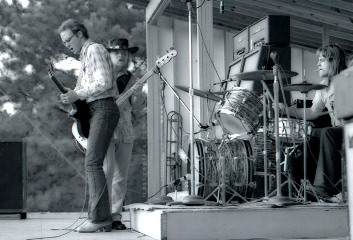
ZZ Top, 1970
The band's name was rumored to have derived from Zig-Zag and TOP rolling papers. Gibbons, however, revealed the true origin of the group's name in his autobiographical book Billy F Gibbons: Rock + Roll Gearhead. Taking notice of Z. Z. Hill and B. B. King posters, Gibbons favored "ZZ" and "King," and came up with "ZZ King," though it was too much like the guitarists' names. Coming to the conclusion that B.B. King was on the "top," Gibbons settled with the name "ZZ Top."

Billy Gibbons
Gibbons was born in Houston, Texas, and, after being bitten by the Elvis bug at the age of seven, began playing guitar. He formed his first band, the Saints, when he was fourteen and eventually moved on to the Coachmen. By 1967 he was working with a trimmed-down, four-member psychedlic combo called the Moving Sidewalks. Their single "99th Floor" stayed on top of the Texas charts for five weeks and earned the band a spot as opening act for the Jimi Hendrix Experience in 1968. Hendrix was so impressed with Gibbons’s fretwork that he cited the Texan as one of America’s best guitarists on a "Tonight Show" television appearance.
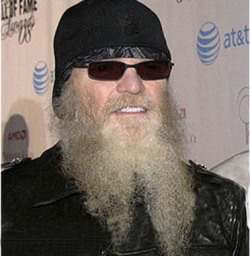
Dusty Hill
Gibbons and Bill Ham, a local record promo man, began auditioning drummers and bassists before settling with two veterans of the Texas blues scene, Dusty Hill and Frank Beard. Hill, a Dallas native, also entered music after seeing a Presley performance on television and began playing the bass when he was thirteen. Along with his brother, guitarist Rocky Hill, they formed the Deadbeats before playing in Lady Wild and the Warlocks. After that band folded in 1967, the two joined drummer Beard’s American Blues Band. They picked up priceless experience backing up blues legends like Lightnin’ Hopkins, Jimmy Reed, and Freddie King.

Frank Beard
On February 10, 1970, the three musicians were united. "We threw a jam session together that fateful day," Gibbons informed Guitar World. "We started off with a shuffle in C and didn’t quit for a couple of hours. We decided that it was so much fun that we kept on cookin’." They knew they had a great sound together, but they also realized that it takes even more to make it in the music world.
Their First Album LP received little fanfare. Things began to pick up with their second album Rio Grande Mud. Word began to spread as the Rolling Stones asked the boys to open for their 1972 tour. They scored a national hit with "La Grange" from the platinum-selling Tres Hombres.
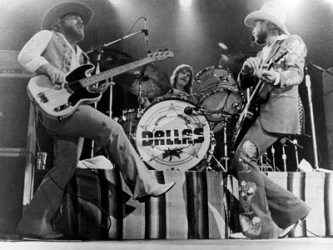
ZZ Top
It was obvious by now that ZZ Top could play the blues as well as anyone, but they approached it without the scholarly attitude that causes so many other groups to sink. "See, for white boys playing the blues, you can only get away with it if it’s amusing," Gibbons told Rolling Stone’s Daisann McLane.
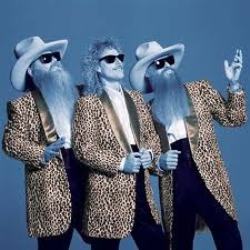
ZZ Top - Blue Jean Blues
"Tush" is a fine example of the warped lyrics that have helped ZZ Top become a party favorite. The song, along with "Blue Jean Blues," helped to keep their 1975 release Fandango on the charts for an amazing eighty-three weeks and to eventually sell more than a million copies. The album contains one studio side and the other recorded live at New Orleans’s Warehouse.
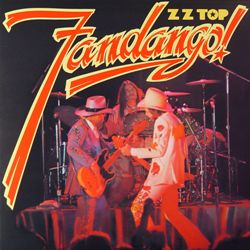
ZZ Top - Fandango, cover
Their next tour, the 1976 World-Wide Texas Tour in support of Tejas, was an enormous undertaking that established ZZ Top as one of rock’s premier live acts. With a giant Texas-shaped stage adorned with actual cattle, bison, rattlesnakes, coyotes, and tarantulas, the tour proved to be one of the most successful ever by grossing over $11.5 million.
After years of touring, the band went on a two-year break in 1977. Although they returned in 1979 and the band signed a new deal with Warner Bros. Records, it was not until the band released 1983's Eliminator that they reached a new height in popularity, selling over 10 million copies. Throughout the late 1980s, the band made several hits and won several awards for music videos.
After over 40 years of performing with the same members, the band continues to tour and record music. They were inducted into the Rock and Roll Hall of Fame in 2004.
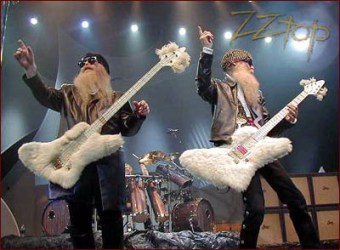
ZZ Top
ZZ Top Blue Jean Blues Lyrics
I done ran into my baby And fin'lly found my old blue jean. I done ran into my baby And fin'lly found my old blue jean. Well, I could tell that they was mine From the oil and the gasoline. If I ever get back my blue jean, Lord, how happy could one man be. If I ever get back my blue jean, Lord, how happy could one man be. 'Cause if I get back those blue jean You know, my baby be bringin' 'em home to me.

ZZ Top - Blue Jean Blues
Last Updated (Wednesday, 18 March 2015 14:50)








